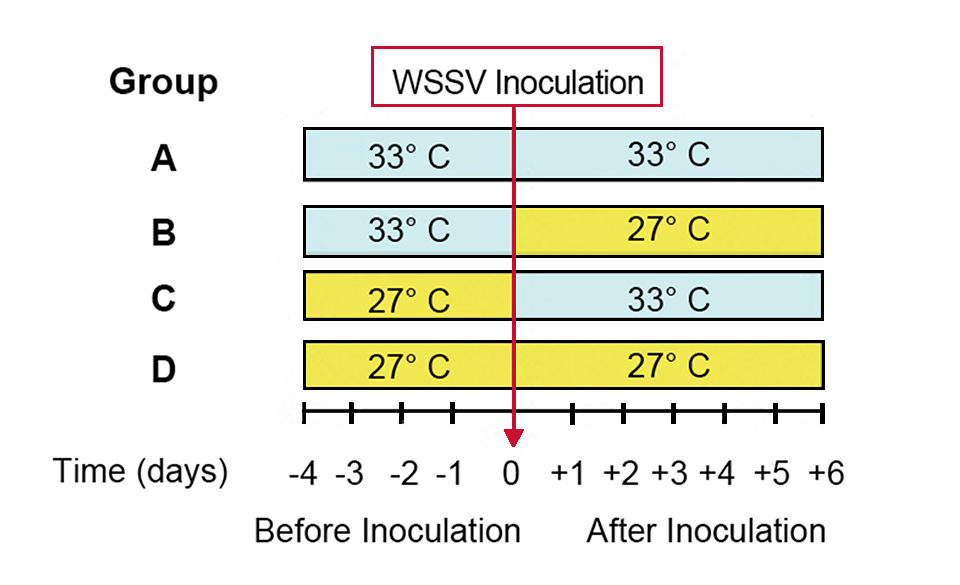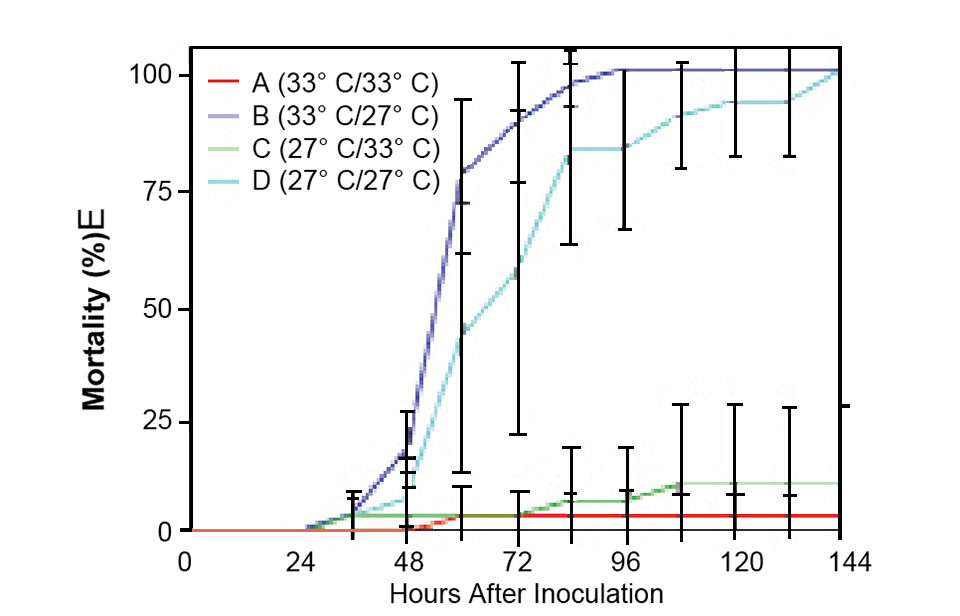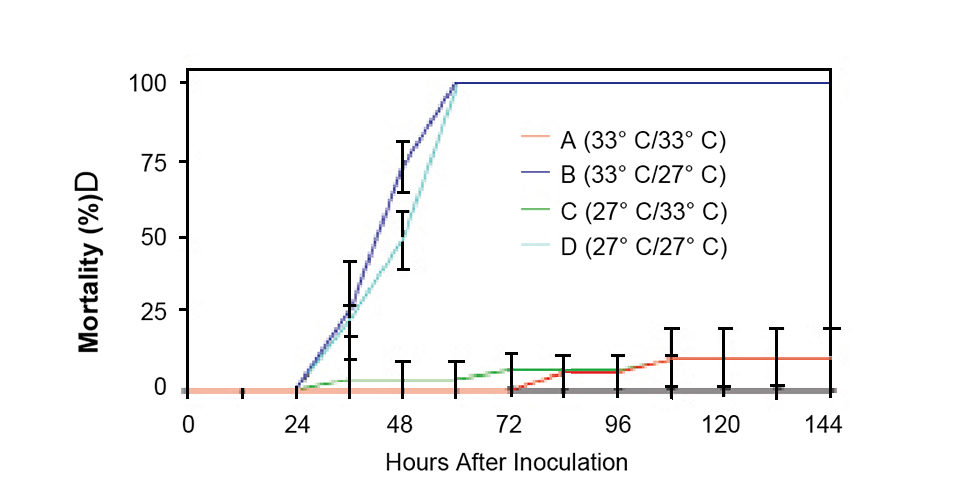Increasing to 33 degrees-C after inoculation prevented WSSV-induced mortality
Several reports have showed that maintaining shrimp infected with White Spot Syndrome Virus (WSSV) at a high water temperature of 33 degrees-C effectively reduces mortality. In a recent study by the authors, a standardized intramuscular inoculation procedure was used to evaluate the effects of high water temperature before and/or after inoculation on the virological and clinical outcome of WSSV infection.
Study setup
Specific pathogen-free Pacific white shrimp (Penaeus vannamei) of approximately 14 grams mean body weight were inoculated intramuscularly with a high or low dose of WSSV. Four groups of 10 shrimp for each dose were kept at different temperatures before and after inoculation (Fig. 1).

Group A was kept at 33 degrees-C before and after inoculation. Group B was kept at 33 degrees-C before inoculation with temperature decreased to 27 degrees-C after inoculation. Group C was kept at 27 degrees-C before inoculation, and then temperature was raised to 33 degrees-C. Finally, group D remained at 27 degrees-C for the duration of the experiment. The experiments were repeated three times.
After WSSV inoculation, shrimp were monitored every 12 hours for clinical signs of reduced feeding and lethargy. Dead shrimp and those surviving at the end of the experiments were collected and processed to detect WSSV by indirect immunofluorescence.
Results
As shown in Fig. 2, shrimp in groups A and C given low doses of WSSV had mortalities of 0-10 percent and 0 to 30 percent, respectively, at the end of the experiments. All shrimp in group B died 72 to 96 hours after inoculation, and those in D died within 84 to 144 hours.

With the high dose, groups A and C had mortalities of 0 to 10 percent and 0 to 20 percent, respectively (Fig. 3). All shrimp in groups B and D were dead by 60 hours.

All shrimp from groups A and C were found negative for both inoculation doses. All shrimp from groups B and D were WSSV-positive.
Temperature effects
The study results showed that raising water temperature to 33 degrees-C after White Spot inoculation was sufficient to prevent WSSV-induced mortality. Using high water temperature before inoculation had no protective effect. The shrimp kept at 33 degrees C after inoculation were negative to WSSV, which demonstrated that infection, or at least the replication of the virus, was blocked by the higher water temperature.
(Editor’s Note: This article was originally published in the February 2006 print edition of the Global Aquaculture Advocate.)
Now that you've finished reading the article ...
… we hope you’ll consider supporting our mission to document the evolution of the global aquaculture industry and share our vast network of contributors’ expansive knowledge every week.
By becoming a Global Seafood Alliance member, you’re ensuring that all of the pre-competitive work we do through member benefits, resources and events can continue. Individual membership costs just $50 a year. GSA individual and corporate members receive complimentary access to a series of GOAL virtual events beginning in April. Join now.
Not a GSA member? Join us.
Authors
-
Victoria Alday-Sanz, Ph.D.
Aquatic Animal Health Consultant
Otterstraat 70
9200 Dendermonde, Belgium -
C.M. Escobedo-Bonilla
Laboratory of Virology
Ghent University
Merelbeke, Belgium -
M. M. Rahman
Laboratory of Virology
Ghent University
Merelbeke, Belgium -
M. Corteel
Laboratory of Virology
Ghent University
Merelbeke, Belgium -
J.J. Dantas-Lima
Laboratory of Virology
Ghent University
Merelbeke, Belgium -
M.B. Pensaert
Laboratory of Virology
Ghent University
Merelbeke, Belgium -
H.J. Nauwynck
Laboratory of Virology
Ghent University
Merelbeke, Belgium -
M. Wille
Laboratory of Aquaculture and Artemia Reference Center
Ghent University
Ghent, Belgium -
P. Sorgeloos
Laboratory of Aquaculture and Artemia Reference Center
Ghent University
Ghent, Belgium
Tagged With
Related Posts

Health & Welfare
Alphavirus replicon particles potential method for WSSV vaccination of white shrimp
A study demonstrated that VP19 and VP28 white spot syndrome virus envelope proteins expressed by replicon particles provided protection against mortality due to WSSV in shrimp.

Health & Welfare
CENIACUA develops WSSV-resistant shrimp in Colombia
To combat white spot syndrome virus (WSSV) in white shrimp, Corporación Centro de Investigación de la Acuacultura de Colombia (CENIACUA) initiated a selective-breeding program to develop resistance in shrimp.

Health & Welfare
A comprehensive look at the Proficiency Test for farmed shrimp
The University of Arizona Aquaculture Pathology Laboratory has carried out the Proficiency Test (PT) since 2005, with 300-plus diagnostic laboratories participating while improving their capabilities in the diagnosis of several shrimp pathogens.

Responsibility
A look at various intensive shrimp farming systems in Asia
The impact of diseases led some Asian shrimp farming countries to develop biofloc and recirculation aquaculture system (RAS) production technologies. Treating incoming water for culture operations and wastewater treatment are biosecurity measures for disease prevention and control.


